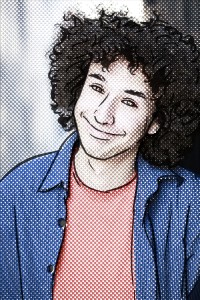Comic books are everywhere – Marvel and DC Comics are mining decades of storylines for a huge slate of movies and television shows. But comics are more than a source to be mined for superhero blockbusters. New creators are dealing with issues every month in ways that couldn’t be done in other formats – issues of comic books.
You might have noticed that many movies and television shows recently are adapted from comic books. Over 30 movies and a dozen TV series based on Marvel and DC characters are coming in the next decade.
“The Walking Dead” is a long-running Image Comics series. Frank Miller’s “Sin City” and “300” both spawned franchises, too. Last year’s “Snowpiercer” is a Korean film in English based on a French graphic novel. Some, like “30 Days of Night,” use scripts intended for film and make comics as a kind of pilot attempt towards their movie and television aspirations. It’s easier to make a film out of a known property than it is to launch a new franchise in today’s market, so pre-existing but obscure works – like, say, “Cowboys & Aliens,” “Men in Black” or “Kingsman: The Secret Service” become the productions of choice.
Comics are a visual medium, like film and television. One key difference is that comics move in space on a page, rather than time. Where a film can linger on an important scene, a comic must use the way the eye lingers on larger panels or smaller panels to draw attention.
Given the recent hack of Sony Pictures, it’s relatively unsurprising that New Regency canceled an adaptation of Guy Delisle’s “Pyongyang: A Journey in North Korea,” a French graphic novel, which would’ve starred Steve Carell. “Pyongyang” is an introspective travelogue about the author’s time as an animation consultant in North Korea’s capital.
Over Delisle’s two months in Pyongyang, he sees the poorly-constructed facade of the Kim Jong Il regime as a face that it presents to outsiders. North Korea is shown, not as the threat it wants to be seen as, but rather as the repressive, backward state Delisle sees.

If anything, “Pyongyang” as a film could have been even more ridiculous in its portrayal of the regime than that of “The Interview.” Fortunately, you can still read the comic even though the film isn’t getting made.
It isn’t an inherent improvement to turn a comic book into a movie, although the audience may be larger. That’d be like saying the “Harry Potter” novels weren’t validated until Daniel Radcliffe came along. There are comics so suited to their medium that they’re totally unadaptable. The adaptation succeeds and fails on its own merit. I’m certainly not in favor of slavish devotion to an original work – the structural tricks Alan Moore and Dave Gibbons used in “Watchmen” didn’t take well to film.
The process of adaptation works the other way around, too. Comic book adaptations of film, television or novels adapt an existing storyline or create an expanded universe take. These have often been shoddy – although licensed comic publisher IDW Publishing’s recent purchase of more literary publisher Top Shelf Productions offers hope in that regard. But when done well, they stand up in their own right. What you’ll like depends on your previous interest.
One great recent licensed comic is James Stokoe’s “Godzilla: Half Century War,” a miniseries that leans on decades of Toho’s original “Godzilla” mythology. That continuity, while there if you can appreciate it, isn’t needed to enjoy the comic – I can barely tell Rodan from Anguirus.
“Half Century War” places all of those films in a historical context, from Godzilla’s first appearance just after World War II into the late 20th century, a world wracked for decades by rampaging god-monsters.
One advantage comics have is that they don’t need sets, CGI or actors. They’re like movies with effectively infinite budgets – limited only by the creative team’s skill and imagination.
Stokoe’s hyper-detailed rendering and wild, energetic colors make Godzilla a hulking, overwhelming force. A sense of scale is one of the toughest things to get across in comics. Here, Godzilla kicks up dust and buildings, wrecking as well on page as in a theater.
“Half Century War” works because it clearly comes from a love of the material in addition to a work-for-hire paycheck. It shares the same manic intensity as Stokoe’s indie series “Orc Stain,” with more mainstream sensibilities.
If you want to know what that “Doctor Strange” movie will look like, read Steve Ditko and Stan Lee’s trippy original run. If you can’t wait for the “Justice League” movie, read Grant Morrison and Howard Porter’s “JLA.” If you couldn’t care less about either movie, read them anyway. They’re excellent, character-defining stories in their own right. Many people on these work-for-hire series, whether licensed or superhero, have their own projects, closer to their heart. Look for them, and follow them back to their best work.
What comic books have you read lately? Could Superman outrun the Flash? Email Greenberg at jogreenberg@media.ucla.edu.

